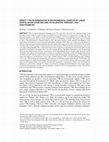Papers by Rafael Garcia-tenorio
Oceans '04 MTS/IEEE Techno-Ocean '04 (IEEE Cat. No.04CH37600), 2004
ABSTRACT
Food Science and Technology, 2006
Nuclear Physics News, 2011
Nuclear Instruments and Methods in Physics Research Section B: Beam Interactions with Materials and Atoms, 1988
Nuclear Instruments and Methods in Physics Research Section B: Beam Interactions with Materials and Atoms, 1992
A complete study of the elemental concentration distribution in a Swedish lake has been done usin... more A complete study of the elemental concentration distribution in a Swedish lake has been done using PIXE as a multielemental analytical technique. More than 40 samples from 20 different locations of the lake were analyzed and about 20 elements were determined for each sample. From the obtained data the spatial and temporal distribution of the more significative constituents of the sediment matrix were analyzed and the impact of the human activities during the last century was evaluated.
Journal of Radioanalytical and Nuclear Chemistry, 2008
A complete methodology for 226 Ra and 228 Ra determination by alpha-particle spectrometry in envi... more A complete methodology for 226 Ra and 228 Ra determination by alpha-particle spectrometry in environmental samples is being applied in our laboratory using 225 Ra as an isotopic tracer. This methodology can be considered highly suitable for the determination of these nuclides when very low absolute limits of detection need to be achieved. The 226 Ra determination can be performed at any time after the isolation of the radium isotopes from the analyzed samples while the 228 Ra determination needs to be carried out at least six months later through the measurement of one of its grand-daughters. The method has been validated by its application to samples with known concentrations of these Ra nuclides, and by comparison with other radiometric methods.
Journal of Environmental Radioactivity, 2004
Riverbed sediments from an estuary historically affected by wastes discharged by several phosphat... more Riverbed sediments from an estuary historically affected by wastes discharged by several phosphate fertiliser plants and enriched in uranium-series radionuclides were operationally speciated using a Tessier-based method. In each selective fraction the 226 Ra content was determined by alpha-particle spectrometry after radiochemical isolation and electrodeposition onto stainless steel planchets.
Czechoslovak Journal of Physics, 1999
A radiochemical method for 226Ra determination by alpha-particle spectrometry in environmental sa... more A radiochemical method for 226Ra determination by alpha-particle spectrometry in environmental samples has been developed in our laboratory. The method has been validated by measurements in samples with known concentrations of this radionuclide and it has been applied in studies related to 226Ra behaviour in phosphogypsum (the main by-product of producing phosphoric acid from phosphate rocks).

Applied Radiation and Isotopes, 1995
North American and European environmental systems have been used to model temporal and spatial en... more North American and European environmental systems have been used to model temporal and spatial environmental changes related to landuse activities and anthropogenic chemical pollution (1 5) specially eutrophication, acidification, heavy metals, halogenated organic substances and radioactive waste. In such studies various combinations (1, 6, 7) of radioactive nuclides have been utilized to trace various environmental processes and to develop relevant time-scales using aquatic particulates and deposits as environmental indicators. Our high resolution chronologies of aquatic deposits along with isotopic ratios in different compartments, that are possible to obtain through various combinations of proper radionuclides, allow to model the evolution of environmental changes and to trace different processes (1, 8) controlling pathways and reaction rates of pollutants from source to sink. Natural and man-made environmental changes, and related consequences on the quality of aquatic life, occurring on regional and global scales could be followed through systematic studies of undisturbed aquatic deposits (lakes, peatlands, soils and marine coasts) from different climatic and geographic regions. Furthermore, the circulation and enrichment of pollutants in aquatic systems can be modelled through their chemical anology with particulate-reactive radionuclides. Within and between system interactions require intensive and tight sampling on temporal and spatial scales.

Science of The Total Environment, 2008
Phosphogypsum (PG), a by-product of the phosphate fertiliser industries, has been applied as soil... more Phosphogypsum (PG), a by-product of the phosphate fertiliser industries, has been applied as soil amendment to reduce Na saturation in soils, as in the reclaimed marsh area from SW Spain, where available PG has a typical fingerprint of 710 ± 40 Bq kg − 1 of 226 Ra, 165 ± 15 Bq kg − 1 of 238 U and 2.8 ± 0.4 mg kg − 1 of Cd. This work was focussed on the cumulative effects of PG amendments on the enrichment of these pollutants in cultivated soils and plants (Lycopersicum esculentum Mill L.) from the area studied, where PG has been applied since 1978 at recommended rates of 20-25 Mg ha − 1 every 2-3 years. A field experiment was conducted over three years to compare activity concentrations of 226 Ra ( 214 Pb) and 238 U ( 234 Th) in non-reclaimed soils, reclaimed soils with no additional PG application, and reclaimed soils with two additional PG applications. A non-significant effect of two PG amendments (in three years) was observed when compared with non-amended reclaimed plots. Nevertheless, a significant (p b 0.05) enrichment of 226 Ra was observed in the surface horizon (0-30 cm) of reclaimed plots relative to deeper horizons and also when compared with the surface horizon of non-reclaimed soil (p b 0.05), thereby revealing the cumulative effect of three decades of PG applications. Furthermore, the effect of a continuous application of PG was studied by analysing soils and tomato fruits from six commercial farms with different cumulative rates of PG applied. Cadmium concentrations in tomatoes, which were one order of magnitude higher than those found in tomatoes from other areas in South Spain, were positively correlated (r = 0.917⁎) with 226 Ra-concentration in soils, which can be considered an accurate index of the cumulative PG rate of each farm.
Résumé/Abstract In this work, the 137 Cs dating technique with improved accuracy is shown to be a... more Résumé/Abstract In this work, the 137 Cs dating technique with improved accuracy is shown to be a powerful tool for establishing chronologies in different (lacustrine, marine) young aquatic deposits. The method has special importance when the 210 Pb method gives partial or unclear results.
Anales de Fisica (Spain)
ABSTRACT

210 Pb is a natural radionuclide belonging to the 238 U series and is one of the most important i... more 210 Pb is a natural radionuclide belonging to the 238 U series and is one of the most important isotopes to be determined in environmental samples because it is considered an excellent tracer of several processes in nature. However, direct determination of this nuclide via traditional radiometric techniques is far from straightforward since 210 Pb emits only relatively soft beta particles and a low-energy gamma ray with a low probability of emission. We propose a rigorous method for direct 210 Pb determination in sediment samples by LSC. The method includes careful calibration and adaptation of the experimental system based on a low-background spectrometer, Quantulus 1220™. There are 2 objectives to the calibration: efficiency improvement and optimum alpha/beta separation using a pulse-shape discrimination system (PSA). On one hand, a detailed study of the PSA system is essential because, after the isolation of 210 Pb from the environmental matrix, some traces of its alpha-emitting daughter 210 Po or other natural alpha emitters might be present during the measurement. Moreover, the appearance of quenching in the sample affects not only counting efficiency but α/β discrimination as well. The quenching effects are also studied in both efficiency considerations and for α/β separation and are included in the calibration. On the other hand, a new approach is proposed based on calculation of an effective radiochemical yield, allowing the determination of 210 Pb levels in the analyzed samples without a previous direct determination of the counting efficiency. 210 Pb counting efficiency determination is avoided because in most of the available standards, 210 Pb is in secular equilibrium with its daughter 210 Bi. As the 210 Bi low-energy tail overlaps in the 210 Pb spectrum, it is difficult to precisely determine the 210 Pb efficiency. The optimized method was applied for determining 210 Pb concentrations in a set of riverbed sediments affected to a quite variable degree by anthropogenic inputs of this nuclide, which has been validated by comparing those results to the ones obtained by applying γ-ray spectrometry. Although it is a direct, non-destructive technique, precise determination of the activity requires knowing the full energy peak efficiency and self-absorption correction for the low-energy gamma ray emitted. This task was performed using Monte Carlo simulation.
Geochmica et Cosmochimica Acta

Revista Mexicana de Fisica
The determination of the specific activities of 210Po and isotopic uranium by alpha spectrometry ... more The determination of the specific activities of 210Po and isotopic uranium by alpha spectrometry was performed in a sediment core from San Marcos Dam. The objective of this work was to analyze the vertical distribution of isotopic uranium and 210Po and the behavior of these radionuclides along sediment core collected from the San Marcos Dam. Sample was divided into 11 sections, in which 210Po and Isotopic Uranium were determined using liquid-liquid extraction with tributyl phosphate (TBP). Furthermore, it was made a comparison between the TBP technique and the technique of extraction chromatography using UTEVA resins for uranium. The results of specific activities for 210Po show a trend to decrease along the core, whereas the uranium isotopic does not show a pointed trend. The results of isotopic ratios between the 234U and 238U show that they are close to secular equilibrium in each of the core sections. The comparison between the two uranium extraction techniques indicates that ch...
On-site studies have shown the radiological impact on the Tinto and Odiel rivers (SW of Spain) by... more On-site studies have shown the radiological impact on the Tinto and Odiel rivers (SW of Spain) by the phosphogypsum produced as wastes in several phosphoric-acid industries located in this area. Leaching of natural radionuclides (Ra-226, Po-210, U-234, U-238) from phosphogypsum piles formed on the bank of the Tinto river has been identified as one of the main routes of radiological impact. The aim of this work was to study the 226Ra and U-isotope leaching behaviour from phosphogypsum for a better understanding of the radiological impact caused in these aquatic systems. (c) 2005 Elsevier Ltd. All rights reserved.
Czechoslovak Journal of Physics
Profiles of artificial fallout (such as 137Cs) and natural radioactivity radionuclides in sedimen... more Profiles of artificial fallout (such as 137Cs) and natural radioactivity radionuclides in sediment cores are useful tools to study sedimentological properties of different aquatic environments as well as to evaluate average sedimentation rates. In the Portil lagoon, a small natural reservoir located in Huelva province (southwest of Spain), and through the analysis of 210Pb, 226Ra, 137Cs, 238U and 210Po vertical profiles in sediment cores, it is shown how the accumulative or transport character of the collection zones may be inferred. In the accumulation zone of the lagoon the influence of focusing effects has been analysed and an average sedimentation rate has been determined through 210Pb in one sediment core. This 210Pb-sedimentation rate is consistent with sediment dating based on the 137Cs data.
Czechoslovak Journal of Physics
A radiochemical sequential extraction procedure has been developed in our laboratory to determine... more A radiochemical sequential extraction procedure has been developed in our laboratory to determine 226Ra and 234,238U by alpha-particle spectrometry in environmental samples. This method has been validated for both radionuclides by comparing in selected samples the values obtained through its application with the results obtained by applying alternative procedures. Recoveries obtained, counting periods applied and background levels found in the alpha spectra give suitable detection limits to allow the Ra and U determination in operational forms defined in riverbed contaminated sediments. Results obtained in these speciation studies show that 226Ra and 234,238U contamination tend to be associated to precipitated forms of the sediments.









Uploads
Papers by Rafael Garcia-tenorio